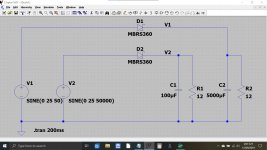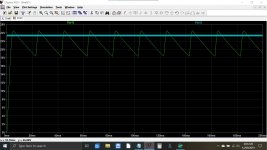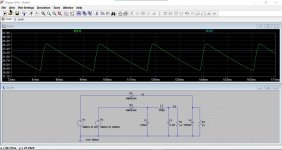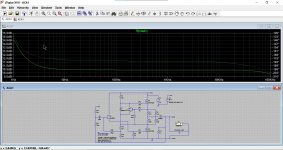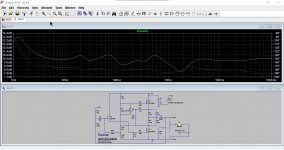Panaman west - the ACA is powered by a 24v 5A laptop computer power supply. The latest generation of these PSU are remarkably quiet, tightly regulated, and sound very, very good. There is no filtering on the PSU in the amplifier itself, none was found to be necessary, although you could certainly experiment and see if you find some benefit to added capacitance. 
Thank you for the information, trying to decide whether to buy a used amp or build one to drive my 94db towers. Would love a first watt but don’t have the budget thus wondering how far from the mark a 1.6 would fall. Nelson’s amps seem to all have no shortage of capacitance which scares me about the 1.6. I don’t want an anemic low end.
When thinking of capacitance (across the rails) you absolutely must understand how the switching supply differs from a conventional transformer/bridge and reservoir cap.
The SMPS runs at very high frequency and so needs a correspondingly smaller cap to achieve the same 'recharge' of the cap. The time between each cycle is just so much shorter.
Have a look at this. Two power supplies, one is running at 50Hz, the other at 50 kHz. The loads are identical and draw just over 2 amps.
Which rail has the most ripple? One has 5000uF and the other just 100uF.
In the SMPS the high frequency ripple will be further reduced by careful filtering, probably using a tiny inductor and another small cap.
Throwing a much larger electrolytic across the SMPS won't kill that ripple, one reason being the relatively poor performance of an electrolytic at HF. Also, and this is very important, adding to much capacitance can upset the operation of the SMPS by causing problems such as poor transient response (voltage output in response to sudden load variations) or in extreme cases cause the supply to either trip or think there is a rail short somewhere.
The SMPS runs at very high frequency and so needs a correspondingly smaller cap to achieve the same 'recharge' of the cap. The time between each cycle is just so much shorter.
Have a look at this. Two power supplies, one is running at 50Hz, the other at 50 kHz. The loads are identical and draw just over 2 amps.
Which rail has the most ripple? One has 5000uF and the other just 100uF.
In the SMPS the high frequency ripple will be further reduced by careful filtering, probably using a tiny inductor and another small cap.
Throwing a much larger electrolytic across the SMPS won't kill that ripple, one reason being the relatively poor performance of an electrolytic at HF. Also, and this is very important, adding to much capacitance can upset the operation of the SMPS by causing problems such as poor transient response (voltage output in response to sudden load variations) or in extreme cases cause the supply to either trip or think there is a rail short somewhere.
Attachments
Thank you for illustrating, that being said in regards to device balance if that is putting it properly , how is the low end in this amp compared to other low watt Pass amps. Looking for great mods and highs but also want good low end as well. Running Tekton Lores. Thanks again. I’m just getting started in the build knowledge part and have much to learn.
My Tekton Lore Reference speakers on mono ACA v1.6's were quite good on the low end, mid-bass especially.
Tried with and without my sub, and it seemed to depend on the recording whether it was really needed or not.
Remember YMMV always applies, but the ACA (better yet, pair of them) is a good bet.
Tried with and without my sub, and it seemed to depend on the recording whether it was really needed or not.
Remember YMMV always applies, but the ACA (better yet, pair of them) is a good bet.
Thank you for illustrating, that being said in regards to device balance if that is putting it properly , how is the low end in this amp compared to other low watt Pass amps. Looking for great mods and highs but also want good low end as well. Running Tekton Lores. Thanks again. I’m just getting started in the build knowledge part and have much to learn.
The ACA interacts with its load more than most amps due mainly to its relatively high output impedance. Another quick simulation example will highlight that. Here we see the ACA into an 8 ohm resistive load and then a reactive load like a speaker. In this case the speaker model is for B&W703 floorstanders. The rise in output at LF for the resistive load is down primarily to the way the feedback is wrapped around the circuit and applied before the input coupling cap.
You can see how the ACA output is altered by the impedance curve of the speaker and it is in many ways it is precisely that interaction that gives the ACA it's colour and musicality.
Attachments
Oh Wow. felt crap this morning fighting a bug that others in the office have been passing round so took a day off work and with very slow, careful determination finshed building my second ACA for bridged monoblock purposes.
Had music going all afternoon sounding very high end. Streaming Tidal service from a Nativ streamer to Cambridge DAC Magic plus and into the ACA and onto Carfrae little big horns (authorised kit version). So the ACA supplies Lowther DX4 in a back loaded horn config with a signal from the speaker cables being taken to drive plate amplifier and subwoofer setup. 106db per watt.
The mind f**K happened when I ran the movie Interstellar from Apple TV through the system. I swear I was looking to the ceiling for bits of rattling spaceship to fall down. The sound stage extends so far out and up from the speakers as to be totally bonkers.
The ACA aren't really driving the subs but the bass rumble coming through is a big improvement. It's got to be the single ended aspect. My normal Amp is a push pull class A Valve amp with seriously expensive output tubes. Maybe single ended valve amps are more like the ACA but I've never had the chance to hear one. Been looking at the Korg B1 options but I read it is boosting the signal which isn't something I need. Think I'd be better off with a passive attenuator set up. What an amazing little amp when hooked up to efficient speakers.
Had music going all afternoon sounding very high end. Streaming Tidal service from a Nativ streamer to Cambridge DAC Magic plus and into the ACA and onto Carfrae little big horns (authorised kit version). So the ACA supplies Lowther DX4 in a back loaded horn config with a signal from the speaker cables being taken to drive plate amplifier and subwoofer setup. 106db per watt.
The mind f**K happened when I ran the movie Interstellar from Apple TV through the system. I swear I was looking to the ceiling for bits of rattling spaceship to fall down. The sound stage extends so far out and up from the speakers as to be totally bonkers.
The ACA aren't really driving the subs but the bass rumble coming through is a big improvement. It's got to be the single ended aspect. My normal Amp is a push pull class A Valve amp with seriously expensive output tubes. Maybe single ended valve amps are more like the ACA but I've never had the chance to hear one. Been looking at the Korg B1 options but I read it is boosting the signal which isn't something I need. Think I'd be better off with a passive attenuator set up. What an amazing little amp when hooked up to efficient speakers.
Alternative Speaker-Connector (binding post)?
Hi all!
I am finally working on the kit, which is really great fun!
Just for aesthetical reasons, I think about using some other speaker-connector.
I am looking for some connectors that appear less "plastic", more humble, more "far-out" or more retro, like just a red and a black hole...
Haven't to be magical material, must not be absolute luxury.
more like these: http://www.solidcoreaudio.de/bilder/DSC_7377.jpg but for amps...
Any suggestions?
Thanks to all!
all the best
d.
Hi all!
I am finally working on the kit, which is really great fun!
Just for aesthetical reasons, I think about using some other speaker-connector.
I am looking for some connectors that appear less "plastic", more humble, more "far-out" or more retro, like just a red and a black hole...
Haven't to be magical material, must not be absolute luxury.
more like these: http://www.solidcoreaudio.de/bilder/DSC_7377.jpg but for amps...
Any suggestions?
Thanks to all!
all the best
d.
Like this:
Red 4mm PANEL MOUNT Socket | Jaycar Electronics New Zealand
Would work if you had banana plugs on your speaker cable.
Red 4mm PANEL MOUNT Socket | Jaycar Electronics New Zealand
Would work if you had banana plugs on your speaker cable.
Myleftear,
If you only want to use 4mm plugs, then these Deltron types are old school and very good quality. They have the advantage that they do not need extra insulation when mounting them on a metal chassis. Loads of colours too.
https://uk.farnell.com/deltron-comp...d-10a/dp/1101100?MER=bn_search_1TP_SearchNB_1
There are a type like Steve has pointed you to, that are in two parts that over come the insulation issue too, cannot find a reference though...
If you only want to use 4mm plugs, then these Deltron types are old school and very good quality. They have the advantage that they do not need extra insulation when mounting them on a metal chassis. Loads of colours too.
https://uk.farnell.com/deltron-comp...d-10a/dp/1101100?MER=bn_search_1TP_SearchNB_1
There are a type like Steve has pointed you to, that are in two parts that over come the insulation issue too, cannot find a reference though...
This a nice ohne, thanks you!
(I got. this in the meantime: on/off hifi : Stecker und Zubehor | PrimeTime Einschlag Bananenhulse, 1 Paar ZST06022 SEB 2600 G M4 RED Sicherheitslaborbuchse Buchse o 4 mm rot SKS Kontakttechnik, still searching)
(I got. this in the meantime: on/off hifi : Stecker und Zubehor | PrimeTime Einschlag Bananenhulse, 1 Paar ZST06022 SEB 2600 G M4 RED Sicherheitslaborbuchse Buchse o 4 mm rot SKS Kontakttechnik, still searching)
There’s a link in the build manual to the exact one just in case you get it too hot when soldering the terminals. Be careful lots of generic ones around that look almost identical but required hole size varies from 19-21mm.
2.24am in NZ can’t sleep so thought i’d Check parcel tracking for packets of audio goodies on their way to me. Have a parcel from HiFi collective UK on its way, pretty sure I saw switched on their site too.
2.24am in NZ can’t sleep so thought i’d Check parcel tracking for packets of audio goodies on their way to me. Have a parcel from HiFi collective UK on its way, pretty sure I saw switched on their site too.
Did I fry something?
Greetings fellow Amp Camp people. I'm new to working with electronics so please excuse my basic problem description. During wiring I accidentally connected the blue and white wires attached to the in/out connections for the left PCB to the right RCA jack (and same reversal for the right PCB and left RCA jack). When I finished all wiring and turned it on one of the transistor sets got very hot very quickly and there was a bit of smoke.
I noticed my error and attached the correct RCA jack to the correct PCB in/out connections.
When power on I don't get hot transistors so that's a good sign. I was able to set the bias on one PCB (approx. 10v) but the other one doesn't get above .2v and adjusting the bias doesn’t appear to do anything.
Did I fry something?
Thanks for your help!
Greetings fellow Amp Camp people. I'm new to working with electronics so please excuse my basic problem description. During wiring I accidentally connected the blue and white wires attached to the in/out connections for the left PCB to the right RCA jack (and same reversal for the right PCB and left RCA jack). When I finished all wiring and turned it on one of the transistor sets got very hot very quickly and there was a bit of smoke.
I noticed my error and attached the correct RCA jack to the correct PCB in/out connections.
When power on I don't get hot transistors so that's a good sign. I was able to set the bias on one PCB (approx. 10v) but the other one doesn't get above .2v and adjusting the bias doesn’t appear to do anything.
Did I fry something?
Thanks for your help!
I can't see how any errors related to the input wiring could cause smoke... I would suspect a different error somewhere on the board.
Voltage measurements are key to fault finding together with a very careful visual inspection of the board and a check that all the correct component values are fitted. The only parts that could 'smoke' would be the 0.47 and 0.68 ohm resistors and the 100 ohm resistors together with either of the output FET's. So check those resistors first.
Comparing the voltages at key areas should help localise the problem.
Voltage measurements are key to fault finding together with a very careful visual inspection of the board and a check that all the correct component values are fitted. The only parts that could 'smoke' would be the 0.47 and 0.68 ohm resistors and the 100 ohm resistors together with either of the output FET's. So check those resistors first.
Comparing the voltages at key areas should help localise the problem.
- Home
- The diyAudio Store
- Amp Camp Amp Kit 1.6/1.8
